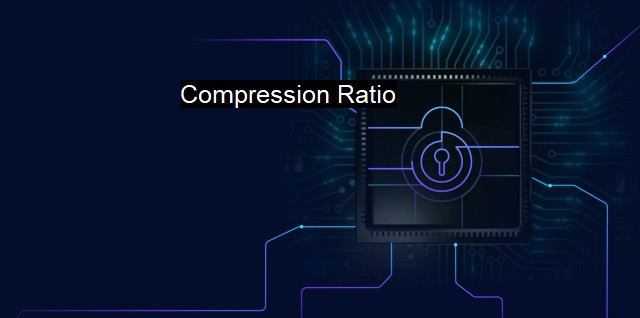What is Compression Ratio?
Maximizing Efficiency: Understanding Compression Ratio in Cybersecurity and Antivirus
Compression Ratio is a crucial concept that has steadily gained prominence in the domain of cybersecurity and antivirus. Simply put, the Compression Ratio is a metric that measures the size of data after compression in relation to its original or uncompressed size.From a technical perspective, the compression ratio represents the reduction in data size resulting from the data or file compression process. Considering a hypothetical example, if original data that sizes up to 100 MB is compressed down to 10 MB, then the compression ratio derived would be approximately 10:1. This implies that the compressed data is almost 1/10th the size of the original data.
Understanding the concept of Compression Ratio is paramount as it corresponds directly to the effectiveness and efficiency of data protection strategies. Data compression algorithms are inherently designed to reduce data size thereby allowing hackers to squeeze large amount of malicious data or malwares into small files. These compressed files can then be easily transmitted over networks, thereby speeding up the spread of malware or viruses, and affording cybercriminals stealth in avoiding detection.
Data compression is a common and legitimate technique associated with optimizing storage use and reducing the bandwidth demand on a network, which in return accelerates the transmission of data to the storage site. Antivirus and information security engines leverage the benefit of compressed files by carrying algorithms that perform decompression to scan for potential malwares even in compressed files.
It is no secret that malware designers and distributors have been particularly witty in their use of compression algorithms. During cybersecurity attacks, data is often packed and compressed with a large Compression Ratio to mask the cyber-breach under routine network traffic. Notably, high compression ratios make it possible to obscure the malicious code, making it harder for the preventive mechanisms like antivirus software and firewalls to detect and mitigate cyber threats preemptively.
In terms of antivirus operations, Compression Ratio holds substantial significance. Advanced antivirus programs are competent in scanning compressed files despite the high compression ratios as they are designed to unpack or decompress files before the scanning process. The objective behind this operation is to augment the level of protection that antivirus programs can offer, and to minimize the chance of any malware slipping through network security measures.
These antivirus programs breach the coding of compressed archives and files such as ZIP or RAR formats, which include the repeatedly compressed files and compressed files with a high Compression Ratio. By examining these potentially hazardous binaries in their decompressed format, antivirus applications eliminate the risks accompanying compressed malware files. This procedure also aids in ensuring comprehensive data protection by detecting hidden or sophisticated forms of threats.
Analyzing the compression ratio forms an integral part of modern cybersecurity assessments and policies for organizations. Regular compression analysis may offer insights on the normal levels of data compression in network traffic, which can be used to detect abnormalities in the case of a security incident.
Compression Ratio, not only serves utility in the general management of data sizes but also holds critical implications in the world of security. It has ramified roles enhancing the avenues through which cybersecurity threats can mask and propagate, while simultaneously providing avenues to facilitate better detection and resistance mechanisms. Recognizing the importance of comprehending and leveraging these aspects of Compression Ratio is essential for executing successful cybersecurity and antivirus strategies.

Compression Ratio FAQs
What is compression ratio in the context of cybersecurity and antivirus?
Compression ratio in cybersecurity and antivirus refers to the amount of data that can be compressed and stored in a smaller space or transmitted in lesser time without losing any information. It is calculated by dividing the original size of the file by the compressed size. Higher compression ratio means more efficient use of storage and bandwidth resources.How does compression ratio affect the performance of antivirus software?
Compression ratio affects the performance of antivirus software by impacting the time taken to scan files. Highly compressed files take longer to scan as they need to be decompressed first. However, if the compression ratio is high, it can also reduce the disk space and memory usage of antivirus software. This means the software can handle more files simultaneously and perform faster scans.Can high compression ratio affect the effectiveness of antivirus software?
High compression ratio can potentially affect the effectiveness of antivirus software as some viruses can hide in compressed files. However, modern antivirus software can detect and scan compressed files for viruses. It is recommended to use antivirus software that has the capability to scan compressed files to ensure complete protection against viruses.Can changing the compression ratio of a file affect the integrity of the file?
Changing the compression ratio of a file can potentially affect the integrity of the file as it involves compressing and decompressing the file. If the compression algorithm used is not reliable, it could result in loss of data or corruption of the file. It is important to use trusted and reliable compression software to ensure the integrity of the file.| | A | | | B | | | C | | | D | | | E | | | F | | | G | | | H | | | I | | | J | | | K | | | L | | | M | |
| | N | | | O | | | P | | | Q | | | R | | | S | | | T | | | U | | | V | | | W | | | X | | | Y | | | Z | |
| | 1 | | | 2 | | | 3 | | | 4 | | | 7 | | | 8 | | |||||||